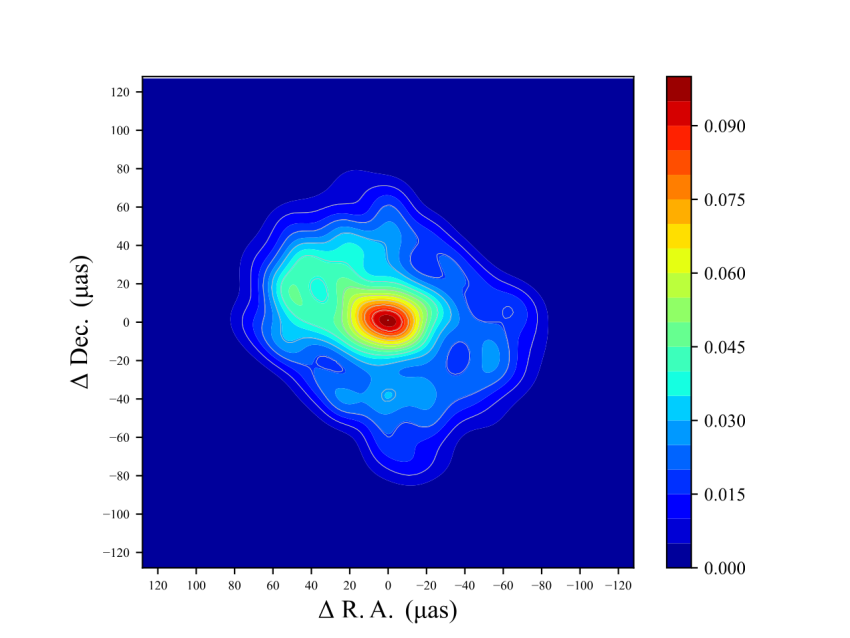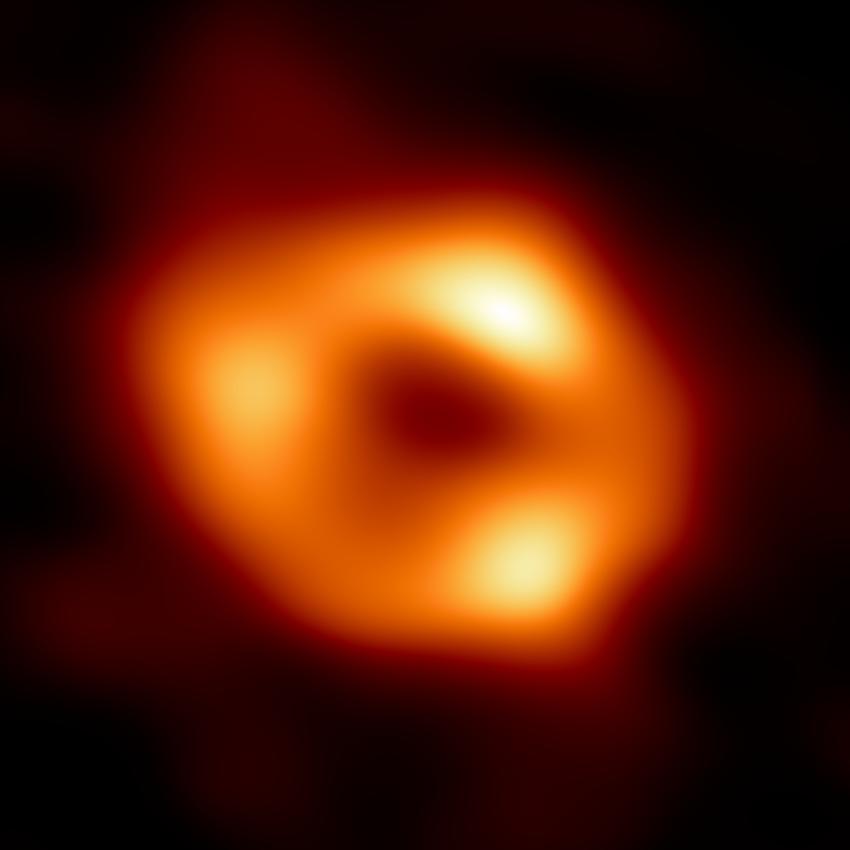The first picture of the supermassive black hole at the heart of our Milky Way galaxy may not be a true reflection of its appearance, new research suggests.
Astronomers led by the National Astronomical Observatory of Japan (NAOJ) say their analysis points at Sagittarius A* having an elongated accretion disk, as opposed to the ring-like “doughnut” image released in 2022 by an international team called the Event Horizon Telescope (EHT) collaboration.
The EHT image shows a central dark region where the hole resides, circled by the light coming from super-heated gas accelerated by immense gravitational forces.
But a new paper published today in Monthly Notices of the Royal Astronomical Society suggests that part of this appearance may actually be an artefact because of the way the image was put together.
It’s important to point out, however, that many researchers have validated the results of the EHT image.
Assistant professor Miyoshi Makoto, of the NAOJ, said: “Our image is slightly elongated in the east-west direction, and the eastern half is brighter than the western half.
“We think this appearance means the accretion disk surrounding the black hole is rotating at about 60 per cent of the speed of light.”
He added: “Why, then, did the ring-like image emerge? Well, no telescope can capture an astronomical image perfectly.
“We hypothesise that the ring image resulted from errors during EHT's imaging analysis and that part of it was an artefact, rather than the actual astronomical structure."
The EHT observed Sagittarius A* in 2017 with a network of eight ground-based radio telescopes using a technique known as radio interferometry to combine the results from the various telescopes.
The results of these observations were published in 2022, including an image of a bright ring structure surrounding a central dark region, indicating the presence of a black hole.
In contrast to typical photography, data from observations linking several widely-separated radio telescopes contain many gaps in the completeness, the researchers behind the new paper argue, so special algorithms are used to construct an image from the data.
In this research, the team applied widely-used traditional methods to EHT data, as opposed to the EHT’s own original analysis method.
Although the appearance of Sagittarius A* put forward by the new paper differs from the results of the EHT team, both are plausible structures derived from the data using the respective methods.
Researchers behind the latest study hope that a more reliable picture of Sagittarius A* will emerge with the help of further discussions by astronomers, along with improved analysis methods and data from follow-up observations carried out since 2018.
The Milky Way galaxy, in which we live, contains more than 100 billion sun-like stars.
There are countless such large galaxies in the Universe, most of which are thought to have supermassive black holes at their centres with masses millions to billions of times that of the Sun.
These black holes swallow everything, including light, making it impossible to see the supermassive black hole itself. However, analysis of stars circling the black hole at high speed indicates that Sagittarius A* has a mass approximately 4 million times that of the Sun.
By closely observing its surroundings, researchers can obtain clues to the nature of the invisible black hole.
The paper ‘An Independent Hybrid Imaging of Sgr A* from the Data in EHT 2017 Observations’ by Makoto Miyoshi et al has been published in Monthly Notices of the Royal Astronomical Society.
Media contacts
Sam Tonkin
Royal Astronomical Society
Mob: +44 (0)7802 877 700
Dr Robert Massey
Royal Astronomical Society
Mob: +44 (0)7802 877 699
Science contacts
Assistant professor Miyoshi Makoto
National Astronomical Observatory of Japan
Images and captions
New radio image of Sagittarius A*
Caption: Radio image of Sagittarius A* in the centre of the Milky Way galaxy, obtained from re-analysis by new research. The structure is elongated from east to west. The east side is bright and the west side is dark, which the research team interprets to mean that the east side is moving towards us.
Credit: Miyoshi et al.
Caption: The first ever image of Sagittarius A*, the supermassive black hole at the centre of the Milky Way, which was released to the public in 2022. It depicts a ring-like “doughnut” of super-heated gas surrounding the black hole.
Credit: EHT collaboration
Further information
The new study ‘An Independent Hybrid Imaging of Sgr A* from the Data in EHT 2017 Observations’, Makoto Miyoshi et al., has been published in Monthly Notices of the Royal Astronomical Society.
Notes for editors
About the Royal Astronomical Society
The Royal Astronomical Society (RAS), founded in 1820, encourages and promotes the study of astronomy, solar-system science, geophysics and closely related branches of science.
The RAS organises scientific meetings, publishes international research and review journals, recognises outstanding achievements by the award of medals and prizes, maintains an extensive library, supports education through grants and outreach activities and represents UK astronomy nationally and internationally. Its more than 4,000 members (Fellows), a third based overseas, include scientific researchers in universities, observatories and laboratories as well as historians of astronomy and others.
The RAS accepts papers for its journals based on the principle of peer review, in which fellow experts on the editorial boards accept the paper as worth considering. The Society issues press releases based on a similar principle, but the organisations and scientists concerned have overall responsibility for their content.



